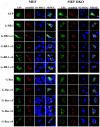µ-Calpain conversion of antiapoptotic Bfl-1 (BCL2A1) into a prodeath factor reveals two distinct alpha-helices inducing mitochondria-mediated apoptosis
- PMID: 22745672
- PMCID: PMC3379997
- DOI: 10.1371/journal.pone.0038620
µ-Calpain conversion of antiapoptotic Bfl-1 (BCL2A1) into a prodeath factor reveals two distinct alpha-helices inducing mitochondria-mediated apoptosis
Abstract
Anti-apoptotic Bfl-1 and pro-apoptotic Bax, two members of the Bcl-2 family sharing a similar structural fold, are classically viewed as antagonist regulators of apoptosis. However, both proteins were reported to be death inducers following cleavage by the cysteine protease µ-calpain. Here we demonstrate that calpain-mediated cleavage of full-length Bfl-1 induces the release of C-terminal membrane active α-helices that are responsible for its conversion into a pro-apoptotic factor. A careful comparison of the different membrane-active regions present in the Bfl-1 truncated fragments with homologous domains of Bax show that helix α5, but not α6, of Bfl-1 induces cell death and cytochrome c release from purified mitochondria through a Bax/Bak-dependent mechanism. In contrast, both helices α5 and α6 of Bax permeabilize mitochondria regardless of the presence of Bax or Bak. Moreover, we provide evidence that the α9 helix of Bfl-1 promotes cytochrome c release and apoptosis through a unique membrane-destabilizing action whereas Bax-α9 does not display such activities. Hence, despite a common 3D-structure, C-terminal toxic domains present on Bfl-1 and Bax function in a dissimilar manner to permeabilize mitochondria and induce apoptosis. These findings provide insights for designing therapeutic approaches that could exploit the cleavage of endogenous Bcl-2 family proteins or the use of Bfl-1/Bax-derived peptides to promote tumor cell clearance.
Conflict of interest statement
Figures





Similar articles
-
Bcl-2 family member Bfl-1/A1 sequesters truncated bid to inhibit is collaboration with pro-apoptotic Bak or Bax.J Biol Chem. 2002 Jun 21;277(25):22781-8. doi: 10.1074/jbc.M201469200. Epub 2002 Apr 19. J Biol Chem. 2002. PMID: 11929871
-
C-terminal residues regulate localization and function of the antiapoptotic protein Bfl-1.J Biol Chem. 2009 Oct 30;284(44):30257-63. doi: 10.1074/jbc.M109.040824. Epub 2009 Sep 15. J Biol Chem. 2009. PMID: 19759007 Free PMC article.
-
N-terminal cleavage of bax by calpain generates a potent proapoptotic 18-kDa fragment that promotes bcl-2-independent cytochrome C release and apoptotic cell death.J Cell Biochem. 2000 Sep 18;80(1):53-72. doi: 10.1002/1097-4644(20010101)80:1<53::aid-jcb60>3.0.co;2-e. J Cell Biochem. 2000. PMID: 11029754
-
Structural biology of the Bcl-2 family of proteins.Biochim Biophys Acta. 2004 Mar 1;1644(2-3):83-94. doi: 10.1016/j.bbamcr.2003.08.012. Biochim Biophys Acta. 2004. PMID: 14996493 Review.
-
Mitochondrial membrane permeabilisation by Bax/Bak.Biochem Biophys Res Commun. 2003 May 9;304(3):455-61. doi: 10.1016/s0006-291x(03)00617-x. Biochem Biophys Res Commun. 2003. PMID: 12729579 Review.
Cited by
-
Biological Implications of Differential Expression of Mitochondrial-Shaping Proteins in Parkinson's Disease.Antioxidants (Basel). 2017 Dec 21;7(1):1. doi: 10.3390/antiox7010001. Antioxidants (Basel). 2017. PMID: 29267236 Free PMC article.
-
Bak apoptotic pores involve a flexible C-terminal region and juxtaposition of the C-terminal transmembrane domains.Cell Death Differ. 2015 Oct;22(10):1665-75. doi: 10.1038/cdd.2015.15. Epub 2015 Mar 6. Cell Death Differ. 2015. PMID: 25744027 Free PMC article.
-
MiR-585-3p suppresses tumor proliferation and migration by directly targeting CAPN9 in high grade serous ovarian cancer.J Ovarian Res. 2021 Jul 8;14(1):90. doi: 10.1186/s13048-021-00841-w. J Ovarian Res. 2021. PMID: 34238324 Free PMC article.
-
STEAP4 inhibits cisplatin-induced chemotherapy resistance through suppressing PI3K/AKT in hepatocellular carcinoma.Cancer Metab. 2023 Dec 18;11(1):26. doi: 10.1186/s40170-023-00323-1. Cancer Metab. 2023. PMID: 38111065 Free PMC article.
-
CAPN 7 promotes the migration and invasion of human endometrial stromal cell by regulating matrix metalloproteinase 2 activity.Reprod Biol Endocrinol. 2013 Jul 15;11:64. doi: 10.1186/1477-7827-11-64. Reprod Biol Endocrinol. 2013. PMID: 23855590 Free PMC article.
References
-
- Adams JM, Cory S. The Bcl-2 protein family: arbiters of cell survival. Science. 1998;281:1326. - PubMed
-
- Cory S, Adams JM. The Bcl2 family: regulators of the cellular life-or-death switch. Nat Rev Cancer. 2002;2:656. - PubMed
-
- Muchmore SW, Sattler M, Liang H, Meadows RP, Harlan JE, et al. X-ray and NMR structure of human Bcl-xL, an inhibitor of programmed cell death. Nature. 1996;381:341. - PubMed
-
- Cramer WA, Heymann JB, Schendel SL, Deriy BN, Cohen FS, et al. Structure-function of the channel-forming colicins. Annu Rev Biophys Biomol Struct. 1995;24:641. - PubMed
Publication types
MeSH terms
Substances
LinkOut - more resources
Full Text Sources
Research Materials

